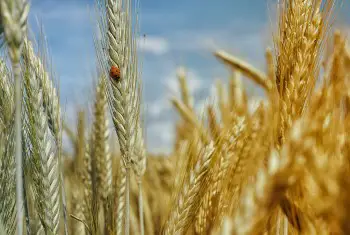We pay attention to a Ladybug if we happen to see one. Delighted by their bright shell, the facts, and folklore surrounding Ladybugs. Intrigued as to how many spots it might have.
What we don’t realize is that there are millions of Ladybugs helping us out – every day, just by the very nature of what they do.
But what do they do? And just how important are they? Well, let’s look at exactly how they help farmers, gardeners, and the ecology. You might be surprised.
Ladybugs are an important link in the insect food chain in our gardens and in agriculture. They voraciously feed on insects that are considered pests, such as Aphids, this, in turn, impacts gardeners and farmers. But their ecosystem is changing, in part due to other invasive species.
Let’s look at why, and what the impact could be.
It’s often down to human intervention or major natural occurrences that species spread. Nature is an ever-changing and diversifying force. Sometimes all we can do is stand back and watch.
But let’s at least arm ourselves with the knowledge of why things happen, the likely outcomes, and what we can do (if anything) to limit our negative involvement in such processes.
To do that, we ideally need to better understand why a species is important to us and the balance of nature…
Why Are Ladybugs Helpful to Humans?
So why are ladybugs important? Ladybugs form an important part of the food chain, mainly because they’re a natural predator of the kind of insects that humans consider pests and which make crop growing difficult.
In terms of gardening and agriculture, Ladybugs are an effective exterminator. Having an abundance of Ladybugs in your garden or within your field of crops means many pesticides are not required, or indeed that they’re just more effective (and natural) than pesticides.

How Many Protection Mechanisms Does a Ladybug Have?
2, 5, or 9?
Find the Answer Here
What Ladybugs Eat Makes Them Important
There are certain species of insects that Ladybugs are particularly good at finding and eating – in large numbers.
They mostly dine on soft-bodied small insects such as aphids. In fact, aphids form part of the Ladybug’s staple diet. Ladybugs can consume up to 50 Aphids in one day, around 5000 over their lifetime.
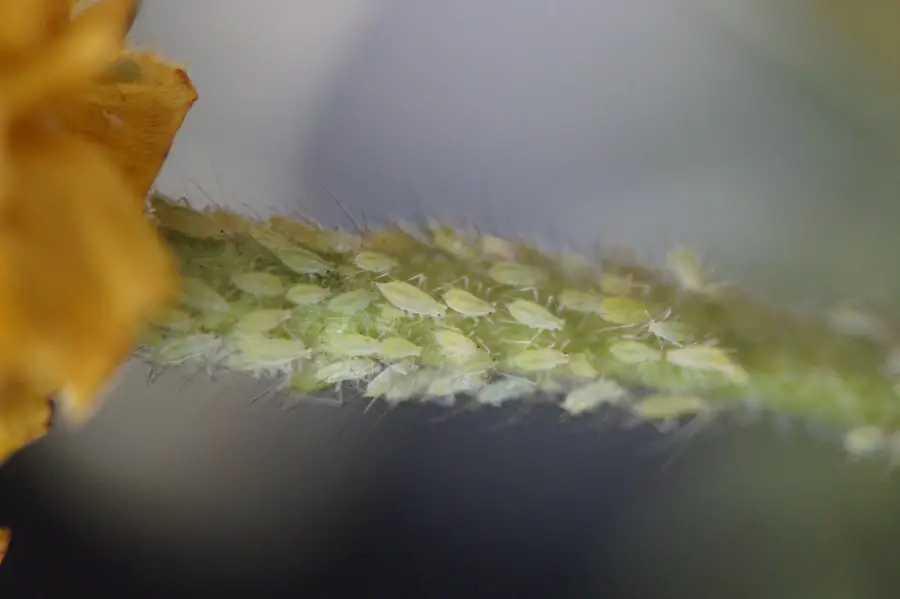
Aphids have plagued farmers for centuries, by blighting crops, they do this by sucking the sap out of plants. Aphids feed and expand in large numbers and there are actually few creatures that hunt them.
In fact, some species of ants can be quite the opposite, as they regularly harvest Aphid farms in order to eat the food they ‘produce’ known as ‘honeydew’.
It’s not only farmers, this happens within our backyards too. You only need to take a look at your rose plants or similar, there’s a chance you’ll find aphids feeding on them which will destroy them – from the inside.
The main species that Ladybugs eat include, but are not limited to the following list…
- Aphids
- Moth eggs
- Moth Larva
- Scales
- Mealybugs
- Thrips
- Chinch Bugs
- Cabbage Flies
- Leaf Hoppers
- Asparagus Beetle larvae
- Whitefly
- Other Beetle Larva
Plus other scale or small soft-bodied insects. This also includes Ladybug larvae who, during this growth stage before turning into a Ladybug, are extremely insatiably Aphid and other insect hunters.
This does not mean all Ladybugs are carnivorous, eating only aphids and other insects. There are many Ladybug species that are omnivores or herbivores, some are known to eat only fungal matter such as mushrooms and fungi.
There are also some that solely eat a variety of other vegetation, such as plant leaves. Here’s the complete list of what ladybugs eat.
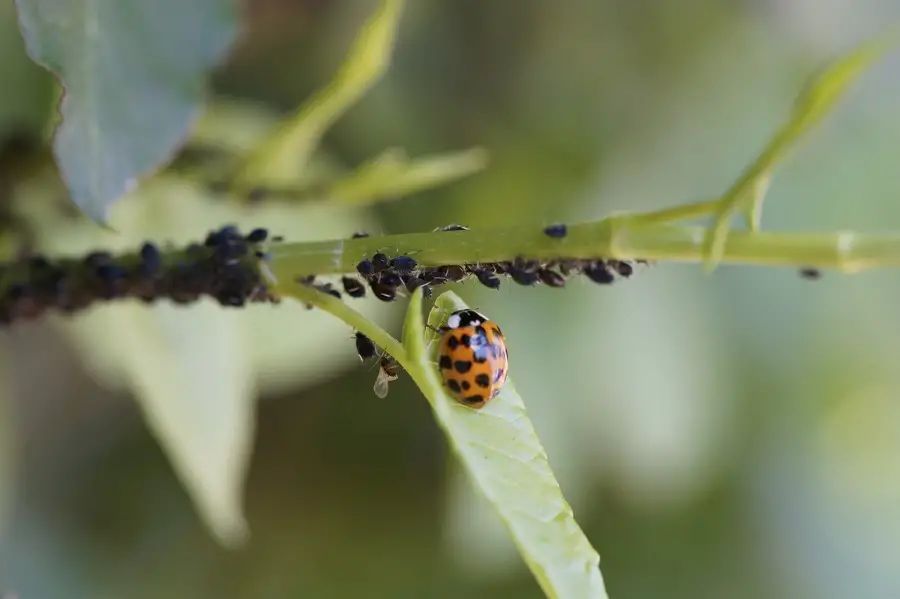
Are Ladybugs Endangered?
Thankfully, this is not about dwindling overall numbers – at least not at this stage. There are around 5000 species of Ladybug worldwide. And of most varieties, there are usually millions, if not billions roaming the planet.
However, a number of those species are either almost extinct or under threat, due to human intervention and the changing climate.
It’s not yet fully known which species are under threat, or have already died out – read on to see how we are trying to better understand what is happening.
It’s about balance in the ecology, and the future changes in climate and species interactions that are threatening Ladybugs – further down the road.

Did You Know…
Ladybugs cannot fly when temperatures are below 55 °F (13°C)
Show me more Amazing Ladybug Facts
Why are Ladybugs Important – Ladybug Evolution
If we look back in history, we know that 100 years ago and long before then, Ladybugs were actually larger than they are today. They have naturally grown in numbers.
The growth in numbers is possibly due to the increase in mass agricultural techniques, which in turn has led to an increase in the pest population, therefore there is a knock-on effect.
An increase in prey has led to a natural boom in the Ladybug population. But also in other predator numbers.
As there were greater numbers of pests, there became greater numbers of Ladybirds but also greater numbers of other competing predators.
Ladybugs learned to adapt through evolutionary change, by reducing in size to the common size we know today. This means that balance was restored between an available food source and predator numbers.
So we know that changes in the balance of the ecosystem have an effect on Ladybug numbers and the way they evolve – like most species.
Fast forward to the 1970s. The growing population of Ladybugs was seen as an infestation that had become too much for the environment. Because of this, the North American Government imported thousands of Asian Lady Beetles from Asia. This continued right through to the 1980s.
“This is not about dwindling overall numbers – at least not at this stage”
Asian Lady Beetle, an Invasive Species
This has certainly opened Pandora’s box. The Asian Lady Beetle, also known as Harlequin Ladybird in the UK. Was originally native to Japan, Korea, China, Russia, and the surrounding region. It’s an aggressive form of Ladybug.
They come in many sizes and colors and are even known to mate with and dine on native species of Ladybugs. They also spread extremely quickly.
See below for the distribution map of the Asian Lady Beetle in North America.
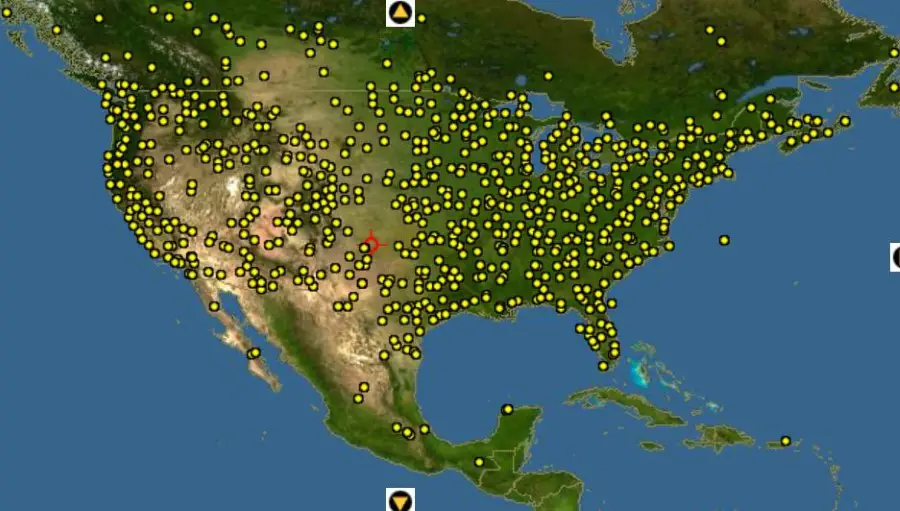
(Image courtesy of discoverlife)
The image below also plots real sightings, showing the spread of the Harlequin population in the UK, recorded over time, from 2003.
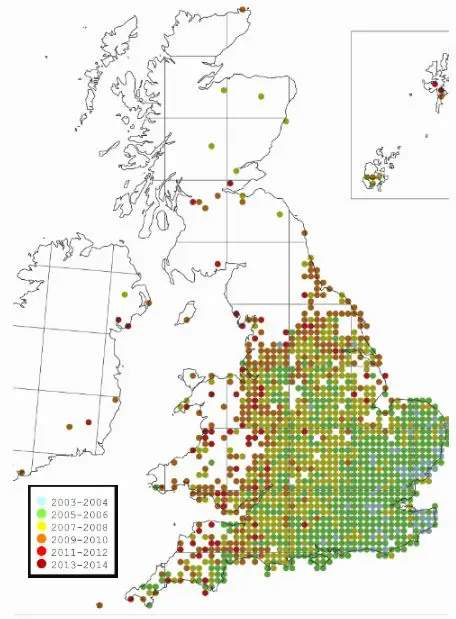
UK Distribution map harlequin (succinea, spectabilis & conspicua)
Image courtesy of harlequin-survey
For this reason, many native Ladybugs are being severely oppressed, in areas now heavily populated by Asian Lady Beetles.
A good example of this is the native 2-spot and 7-spot Ladybirds indigenous to Great Britain. The Asian Ladybug has now found its way to this part of the world and is systematically dominating these native species.
As a result, the numbers of indigenous Ladybugs are falling rapidly and have even been all but wiped out in certain areas.
How to Identify an Asian Lady Beetle / Harlequin
Otherwise known as the Harlequin Ladybird. They come in many varied colors. Generally speaking, Harlequin ladybirds or Asian Lady Beetle fall into one of 3 categories:
- Orange with 15 to 20 black spots
- Black with 2 orange or red spots
- Black with 4 orange or red black spots.
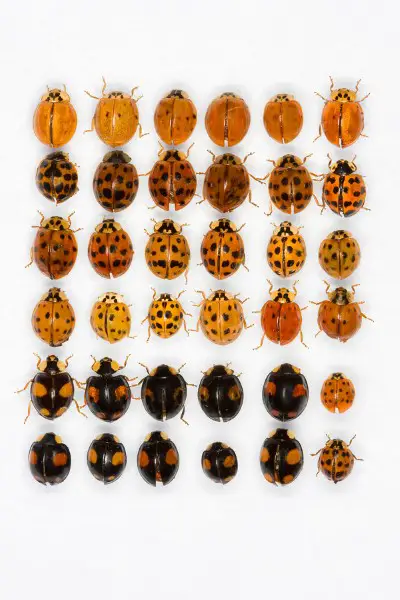
image courtesy of vulcantermite
Here are some other distinct ways in which you can identify them.
- The Harlequin is usually greater than ⅕ inch (5 mm) in length, If it’s ⅕ inch or less it’s not a Harlequin / Asian Lady Beetle.
- If it has 7 black spots on its back, then it’s not a Harlequin/Asian Lady beetle, it’s a native species
- If you can see it is a large burgundy-colored ladybug, with 15 black spots, then it’s a native ‘Eyed’ ladybug
- An orange Pronotum and fine hairs across its elytra, then it’s a native ‘Bryony’ Ladybug
- White or Cream spots, then it’s a ‘Striped’ ladybug, an ‘Orange’ Ladybird, or a ‘Cream-Spot’ Ladybird
- If it’s black with up to six red spots, and if two of those spots are near the front edge of the elytra, then it’s a form of a ‘2-spot’ ladybug.
- A more rounded circular body tends to be an indicator of the Asian Lady Beetle (Harlequin)
What Can We Do to Support Ladybugs
On an individual basis, there’s little effect you can have on the Ladybird population, in terms of hunting or exterminating unwanted species. In any case, one could argue they are all important.
Limiting the use of chemical pesticides would seem one way to help the cause in terms of keeping population numbers high.
However, what you can do is help with the reporting side. I’d recommend taking the following action – depending on your location.
- In North America, the National Science Foundation is carrying out a survey of their own 2-spot and 9-spot Ladybugs. You can get involved too. Follow the instructions given in their guide here, which involves taking and submitting photographic evidence and location details.
- The UK Ladybird Survey is also recording all Ladybird sightings, you can record your findings in much the same way here. Or, download the Ladybug Survey App from here for iPhone, or for Android, the features are the same in principle as the USA version.
- For other areas, you may find smaller specific websites similar to these.
You can help Ladybugs in general by providing a great habitat for them, and by adding a Ladybug House to your garden like my favorite from Amazon. Or you could build your own instead of using these Ladybug House plans.
You can also help by educating our children on Ladybugs, using the information on this site, and also by providing them with a Ladybug Land Breeding study house. And these Ladybug Life Cycle Models which are really helpful for in-class demonstration purposes.
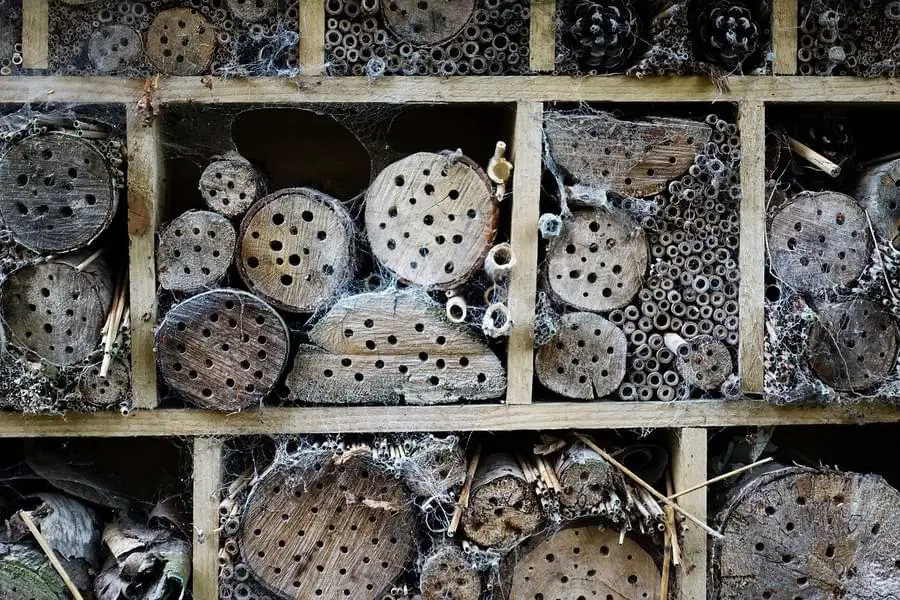
Why are Ladybugs Important – To Close
It’s clear something is not right, we need to assist the research on Ladybug changes across the nations to build up a picture of what is happening. We may not be able to do much about it, but we can at least use it to determine any long-term prospects for the species.
Any long-term demise would have a huge impact on the balance of nature, especially in terms of pest control – which in turn impacts our ability to grow and harvest crops.
But most of the time when we don’t see them – as we do with most insects, we just go about our daily business, not even considering what the Ladybug is achieving for us as they go about their own daily business.
I’d really like to know your thoughts in the comments section, what have you seen of Ladybugs?
Related Questions
Where Are All The Ladybirds Coming From? If you are seeing an increase in Ladybugs, it’s likely that you’re just seeing more than usual as it is Spring and they’re out of hibernation, or that there’s a large influx of Harlequin (or Asian Lady Beetle) into your area. These species are expanding rapidly in parts of North America, the UK, and Europe and are posing a threat to Native Species of 2-spot, 7-spot, and 9-spot Ladybugs.

